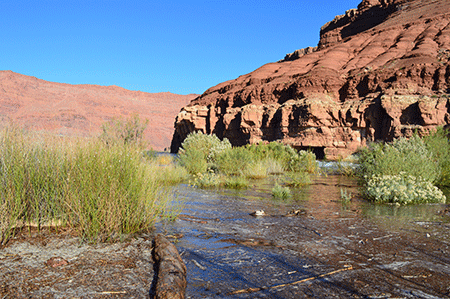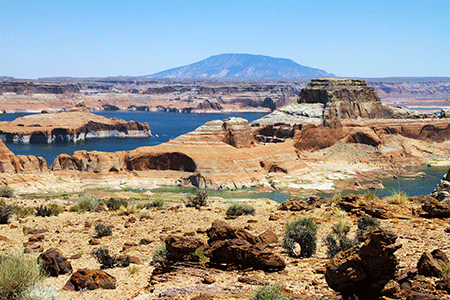- Reclamation
- Upper Colorado Region
- Glen Canyon Dam Adaptive Management Program
Glen Canyon Dam
Adaptive Management Program
The Glen Canyon Dam Adaptive Management Program was developed to provide an organization and process for cooperative integration of dam operations, downstream resource protection and management, and monitoring and research information, as well as to improve the values for which the Glen Canyon National Recreation Area and Grand Canyon National Park were established.
Adaptive management is a dynamic process where people of many talents and disciplines come together to make the right decision in the best interests of the resources.
Current Focus
No Fall 2025 High-Flow Experiment at Glen Canyon Dam
After careful consideration of resources and downstream activities, a fall High-Flow Experiment (HFE) at Glen Canyon Dam will not be implemented in 2025.
The conclusion not to conduct this experiment was based on input from a collaborative team, including Department of the Interior agencies—Bureau of Reclamation, National Park Service, U.S. Geological Survey, U.S. Fish and Wildlife Service, Bureau of Indian Affairs, the Department of Energy's Western Area Power Administration, and representatives from all seven Colorado River Basin States.
The recommendation against conducting the experiment was largely due to the lapse in government appropriations which restricted personnel and the ability to monitor the experiment.
The 2024 Long-Term Experimental and Management Plan (LTEMP) Supplemental Environmental Impact Statement (SEIS) Record of Decision (ROD) introduced a new protocol for HFEs, establishing a year-long sediment accounting period that begins on July 1.
The ROD outlines specific sediment triggers that must be met before an HFE can be considered. The collaborative team will reconvene in late winter 2026 to initiate the planning process for a possible spring 2026 HFE.
Conclusion of Cool Mix Flows
In response to rising river temperatures, the Bureau of Reclamation implemented the release of colder water from deeper in Lake Powell through Glen Canyon Dam. This proactive measure aimed to disrupt the establishment of nonnative fish (specifically smallmouth bass) that pose a danger to the threatened humpback chub.
The trigger for releasing cooler water is three consecutive days of average river temperatures exceeding 60°F at river mile 30 below the dam. Reclamation initiated these flows in earnest on Aug. 12 and the flows concluded on Oct. 20. The target river mile for temperature was moved from river mile 61 to river mile 30 to help limit negative impacts to hydropower during the experiment implementation. Combined with recent changes to the 12-mile slough, the adjusted flows were expected to help continue to reduce the smallmouth bass population while bypassing less than a quarter of the water bypassed last year.
Preliminary findings to determine effectiveness of the flows will be available in early February during the Adaptive Management Work Group Annual Reporting Meeting.
Questions
For further information, contact the project manager by email at: LTEMPSEIS@usbr.gov for more information.
Program Background

Since Glen Canyon Dam was completed in 1963, increasing concern was expressed by the public and federal and state agencies regarding how dam operations may be adversely affecting the downstream environment. To begin addressing these growing concerns, in December 1982, the Bureau of Reclamation initiated the multi-agency interdisciplinary Glen Canyon Dam Environmental Studies at the direction of the Secretary of the Interior.
In November 1989, the Secretary directed an Environmental Impact Statement be prepared on the operation of Glen Canyon Dam, and the Secretary designated Reclamation as the lead agency. This Final EIS, completed in March 1995, received broad and intense interest from water and power users, environmental and conservation groups, Federal and State agencies, Indian tribes, and private citizens across the country.
Findings from the EIS indicated that many uncertainties still exist regarding the downstream impact of water releases from Glen Canyon Dam. The EIS team consolidated the issues of public concern, identifying the significant resources and associated issues to be analyzed in detail. These resources include: water, sediment, fish, vegetation, wildlife and habitat, endangered and other special status species, cultural resources, air quality, recreation, hydropower, and non-use value.
In compliance with the Grand Canyon Protection Act of 1992 (Public Law 102-575), the EIS proposed a process of "adaptive management" whereby the effects of dam operations on downstream resources would be monitored and assessed.
The Act, and the EIS are the guiding documents for development of the Adaptive Management Program. The program meets the purpose and strengthens the intent for which the EIS was prepared, and ensures the primary mandate of the Act is met through future advances in information and resource management.
Section 1802 of the Act directed the Secretary to establish and implement long-term monitoring programs and activities to ensure the Glen Canyon Dam is operated "... in such a manner as to protect, mitigate adverse impacts to, and improve the values for which Grand Canyon National Park and Glen Canyon National Recreation Area were established, including, but not limited to natural and cultural resources and visitor use."
In order to comply with the consultation requirement of the Act, Section 1805 of the Act, the EIS recommended formation of a federal advisory committee. The Transition Work Group was formed to operate until such time as a federal advisory committee could be formed, and a Record of Decision signed by the Secretary of the Interior to initiate a process of "management" (operating criteria for unbiased scientific research and data collection) whereby the effects of dam operations on downstream resources would be assessed. Meetings were held with representatives from the cooperating agencies and public interest groups who provided comments on the criteria for development of reasonable alternatives for the EIS.
The transition group worked on a variety of issues including a long-term monitoring and research program to ensure Glen Canyon Dam is operated in a manner consistent with protecting the downstream environment as well as implementation and management of operations and monitoring in consultation with broad-based interests.
The Record of Decision was signed by the Secretary of Interior in October 1996, and in January 1997, Interior Secretary Babbitt signed a Notice of Establishment of the Glen Canyon Adaptive Management Work Group, a federal advisory committee. The charter of this group was signed on January 15, 1997.
All of the elements are now in place for an effective, credible adaptive management effort. The Adaptive Management Work Group is the key; the Technical Work Group providing detailed guidance on issues and objectives; the Science Center to conduct the research and monitoring needed to evaluate operations; and the independent review panel, the outside review necessary to provide the credible science.
The AMWG continues public involvement in the decision-making process and incorporates those stakeholders with interest in the operation of Glen Canyon Dam and downstream resources. By blending the best science and management practices, the AMWG makes recommendations to the Secretary on how to protect the resources and meet the requirement of the law.
The Adaptive Management Program is administered through a senior Department of the Interior official — designee — and facilitated through the AMWG, which is organized as a federal advisory committee and chaired by the designee.
The AMWG held their first meeting on September 10-11, 1997, and officially formed the Glen Canyon Technical Work Group as a subgroup to work on tasks charged to them by the AMWG.
Back to Quick Nav
Contact us
Bureau of Reclamation
William (Bill) Stewart
125 South State Street, Room 8100
Salt Lake City, Utah 84138-1147
wstewart@usbr.gov
Grand Canyon Monitoring & Research Center
Serena Mankiller
2255 North Gemini Drive
Flagstaff, Arizona 86001
928-556-7094
Fax: 928-556-7092
smankiller@usgs.gov
Related Documents
Current Focus
- GT Max Model Review Panel Final Report Link is to a PDF file
- GT Max Model Review Panel Workshop Participant Comments Link is to a PDF file
- GT Max Expert Review Panel Response to Comments Link is to a PDF file
- Adapitive Management Work Group Charter
- Memorandums and Review - Desired Future Conditions Link is to a PDF file
- Adapitive Management Work Group Operating Procedures Link is to a PDF file
- Technical Work Group Operating Procedures Link is to a PDF file
Law of the River
- Colorado River Compact
- Boulder Canyon Project Act
- California Seven Party Agreement
- Mexican Water Treaty
- Upper Colorado River Basin Compact
- Colorado River Storage Project Act
- Arizona v. California et al.
- Colorado River Basin Project Act
- Criteria For Coordinated Long-Range Operation of Colorado River Reservoirs
- Minute 242 of the U.S. - Mexico International Boundary and Water Commission of 1973
- Colorado River Basin Salinity Control Act
Reports to Congress on Glen Canyon Dam operations
Can be found on our Reports page in the new Document Library.
Reports and Recomendations to the Secretary of the Interior
Stay Connected
Want to stay current on all the activities of the Glen Canyon Dam Adaptive Management Program?
Request to join our mailing lists.
Simply email your first and last name, organization or agency affiliation, and the email address you want to receive the update to bor-sha-ucr-gcdamp@usbr.gov

